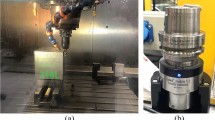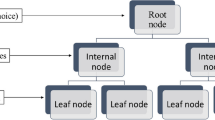Abstract
The main purpose of this paper is to predict the performances of the turning process using an equivalent oblique cutting model. Based on the real tool, an equivalent cut geometry is performed considering the effects of nose and edge radii. Edge direction and normal cutting angles, uncut chip thickness, and depth of cut were redefined by their equivalent values and then used as new inputs. Turning performances, such as cutting force components, cutting temperatures, and tribology parameters at the tool/chip interface, were predicted over a wide range of cutting conditions. The position of the maximum temperature at the tool/chip interface and its value are determined by solving the heat equation in the chip using the Finite Difference Method. Different assumptions were concluded, and the thermal problem is simply resolved using Laplace transform. It was determined that the maximum tool/chip interface temperature is situated far from the cutting edge about \(0.317{\mathrm{l}}_{\mathrm{c}}\). It was also found that the partition coefficient is strongly related to sliding speed and it decreases about 20% when chip velocity increases from 1 to 5 m/s. Acceptable agreement was concluded between experimental cutting force components and those predicted from the equivalent oblique cutting model. It can thus be concluded that the equivalent model of cut is highly recommended to predict turning performances.




















Similar content being viewed by others
Availability of data and materials
All data and materials used to produce the results in this article can be obtained upon request from the corresponding authors.
Availability of code
Code used to produce the results in this article can be obtained upon request from the corresponding authors.
Abbreviations
- \({a}_{p}\) :
-
Cutting depth [mm]
- \({a}_{p}^{eq}\) :
-
Equivalent depth of cut [mm]
- \({c}^{eq}\) :
-
Equivalent work material specific heat [J kg−1 K−1]
- \(f\) :
-
Feed rate [mm/rev]
- \({\tilde{f }}\) :
-
Average coefficient of friction at tool–chip interface
- \({{\tilde{f }}}^{eq}\) :
-
Equivalent average coefficient of friction at tool–chip interface
- \({F}_{c}^{eq}\) :
-
Equivalent tangential force [N]
- \({F}_{f}^{eq}\) :
-
Equivalent feed force [N]
- \({F}_{r}^{eq}\) :
-
Equivalent radial force [N]
- \({F}_{sh}^{eq}\) :
-
Equivalent shearing force [N]
- \({k}^{eq}\) :
-
Equivalent work material thermal conductivity [Wm−1 K−1]
- \({l}_{c}^{i}\) :
-
Tool–chip contact length for element i [mm]
- \({p}_{0}^{eq}\) :
-
Equivalent of maximum normal stress at tool–chip contact [N/mm2]
- \({r}_{\beta }\) :
-
Cutting edge radius [mm]
- \({r}_{\varepsilon }\) :
-
Tool-nose radius [mm]
- \({t}_{1}\) :
-
Uncut chip thickness [mm]
- \({t}_{2}^{eq}\) :
-
Equivalent chip thickness [mm]
- \({T}_{f}\) :
-
Workpiece melting temperature [K]
- \({T}_{0}\) :
-
Initial workpiece temperature [K]
- \({T}_{sh}^{eq}\) :
-
Equivalent shearing temperature [K]
- \({\tilde{T }}_{int}^{eq}\) :
-
Average tool–chip interface temperature [K]
- \({V}_{c}\) :
-
Cutting speed [m/min]
- \({V}_{chip}^{eq}\) :
-
Equivalent chip velocity [mm/s]
- \({V}_{sh}^{eq}\) :
-
Equivalent shearing velocity [mm/s]
- \({\alpha }_{n}\) :
-
Normal rake angle [°]
- \(\delta\) :
-
Secondary shear zone thickness ratio to chip thickness
- \({\phi }_{n}^{eq}\) :
-
Equivalent normal shear angle [°]
- \({\gamma }_{sh}^{eq}\) :
-
Equivalent shear strain
- \({\dot{\gamma }}_{sh}^{eq}\) :
-
Equivalent shear strain rate
- \({\eta }_{c}^{eq}\) :
-
Equivalent chip flow angle [°]
- \({\eta }_{sh}^{eq}\) :
-
Shearing direction angle [°]
- \({\kappa }_{r}\) :
-
Edge direction angle [°]
- \({\kappa }_{r}^{eq}\) :
-
Equivalent edge direction angle [°]
- \({\lambda }_{s}\) :
-
Edge inclination angle [°]
- \({\rho }^{eq}\) :
-
Equivalent work material density [kg/m3]
- \({\tau }_{sh}^{eq}\) :
-
Equivalent shear stress [N/mm2
References
Norouzifard V, Hamedi M (2014) A three-dimensional heat conduction inverse procedure to investigate tool–chip thermal interaction in machining process. Int J Adv Manuf Technol 74:1637–1648. https://doi.org/10.1007/s00170-014-6119-6
Hao G, Liu Z (2020) The heat partition into cutting tool at tool–chip contact interface during cutting process: a review. Int J Adv Manuf Technol 108:393–411. https://doi.org/10.1007/s00170-020-05404-9
Puls H, Klocke F, Veselovac D (2016) FEM-based prediction of heat partition in dry metal cutting of AISI 1045. Int J Adv Manuf Technol 86(1–4):737–745
Huang S, Tao B, Li J et al (2018) On-line estimation of the tool–chip interface temperature field during turning using a sequential inverse method. Int J Adv Manuf Technol 97:939–952. https://doi.org/10.1007/s00170-018-1987-9
Kus A, Yahya Isik MC, Cakir SC, Özdemir K (2015) Thermocouple and infrared sensor-based measurement of temperature distribution in metal cutting. Sensors 15(1):1274–1291. https://doi.org/10.3390/s150101274
Merchant ME (1945) Mechanics of the metal cutting process: I-Orthogonal cutting and a type 2 chip. J Applied physics 16(5):267
Lee EH, Shaffer BW (1951) The theory of plasticity applied to the problem of machining. J Appl Mech 18:405–413
Oxley PLB (1998) Development and application of a predictive machining theory. Mach Sci Technol 2(2):165–189. https://doi.org/10.1080/10940349808945667
Moufki A, Devillez A, Dudzinski D, Molinari A (2004) Thermomechanical modelling of oblique cutting and experimental validation. Int J Mach Tools Manuf 44(2004):971–989
Li B, Hu Y, Wang X, Li C, Li X (2011) An analytical model of oblique cutting with application to end milling. Mach Sci Technol 15(4):453–484
Abdellaoui L, Bouzid W (2016) Thermomechanical approach for the modeling of oblique machining with a single cutting edge. Mach Sci Technol 20(4):655–680. https://doi.org/10.1080/10910344.2016.1224020
Kishawy HA (2002) An experimental evaluation of cutting temperatures during high-speed machining of hardened D2 tool steel. Mach Sci Technol 6(1):67–79
Abdellaoui L, Bouzid W (2016) Thermomechanical modeling of oblique turning in relation to tool-nose radius. Mach Sci Technol 20(4):586–614. https://doi.org/10.1080/10910344.2016.1224017
Lefi A, Hassen K, Sai WB, Hamdi H (2021) Tool nose radius effects in turning process. Mach Sci Technol 25(1):1–30. https://doi.org/10.1080/10910344.2020.1815038
Khlifi H, Abdellaoui L, Hamdi H, Bouzid W (2019). Influence of the nose radius on the cutting forces during turning. In: Benamara, A., Haddar, M., Tarek, B., Salah, M., Fakher, C. (eds) Advances in mechanical engineering and mechanics. CoTuMe 2018. Lecture Notes in Mechanical Engineering. Springer, Cham. https://doi.org/10.1007/978-3-030-19781-0_19
Khlifi H, Abdellaoui L, Bouzid Sai W (2019) An equivalent geometry model for turning tool with nose and edge radii W. Int J Adv Manuf Technol 103:4233. https://doi.org/10.1007/s00170-019-03787-y
Boothroyd G (1963) Temperature in orthogonal metal cutting. Proceedings of the Instrumentation and Mechanical Engineering 177(29):789
Weiner JH (1955) Shear plane temperature distribution in orthogonal cutting. Transactions of the American Society Mechanical Engineers 77:1331
Rapier AC (1954) A theoretical investigation of the temperature distribution in the metal cutting process. Br J Appl Phys 5:400
Bouzid W (1993) Etude expérimentale et numérique de la coupe orthogonale. PhD Thesis, ENSAM
Coromant S (2017) Turning tools. Metalworking products
Sela A, Ortiz de Zarate G, Arrieta I, Soriano D, Aristimuño P, Medina-Clavijo B, Arrazola PJ (2019) A mechanistic model to predict cutting force on orthogonal machining of aluminum 7475-T7351 considering the edge radius. 17th CIRP Conference on Modelling of Machining Operations (17th CIRP CMMO). https://doi.org/10.1016/j.procir.2019.04.066
Günay M, Aslan E, Korkut I, Şeker U (2004) Investigation of the effect of rake angle on the main cutting force. Int J Mach Tools Manu. 44(9):953–959, ISSN 0890–6955. https://doi.org/10.1016/j.ijmachtools.2004.01.015
Astakhov VP (2006) Tribology of metal cutting, tribology and interface engineering series, No 52; Briscoe, B.J.; Eds, London: Elsevier
Iqbal SA, Mativenga PT, Sheikh MA (2009) A comparative study of the tool–chip contact length in turning of two engineering alloys for a wide range of cutting speeds. Int J Adv Manuf Technol 42:30. https://doi.org/10.1007/s00170-008-1582-6
Kulkarni AP, Joshi GG, Karekar A, Sargade VG (2014) Investigation on cutting temperature and cutting force in turning AISI 304 austenitic stainless steel using AlTiCrN coated carbide insert. Int J Mach Mach Mater 15(3–4):147–156
Li K, Liang SY (2005) Modeling of cutting temperature in near dry machining. ASME. J Manuf Sci Eng 128(2):416–424. https://doi.org/10.1115/1.2162907
Mustapha A, Fritz K, Dieter L, Dražen V (2015) The mechanics of cutting: in-situ measurement and modelling. 15th CIRP Conference on Modeling of Machining Operations, Procedia CIRP 31:246–251
Puls H, Klocke F, Lung D (2012) A new experimental methodology to analyse the friction behaviour at the tool–chip interface in metal cutting. Prod Eng Res Devel 6:349–354. https://doi.org/10.1007/s11740-012-0386-6
Funding
This work is carried out with the support and funding allocated to the Unit of Mechanical and Materials Production Engineering (UGPMM/UR17ES43) by the Tunisian Ministry of Higher Education and Scientific Research.
Author information
Authors and Affiliations
Contributions
All the above mentioned authors contributed to the manuscript equally.
Corresponding author
Ethics declarations
Ethics approval
The authors declare that there is no ethical issue applied to this article.
Consent to participate
The authors declare that all authors have read and approved to submit this manuscript to IJAMT.
Consent to publish
The authors declare that all authors agree to sign the transfer of copyright for the publisher to publish this article upon on acceptance.
Conflict of interest
The authors declare no competing interests.
Additional information
Publisher's Note
Springer Nature remains neutral with regard to jurisdictional claims in published maps and institutional affiliations.
Rights and permissions
About this article
Cite this article
Abdellaoui, L., Khlifi, H. & Bouzid Sai, W. Prediction of turning performances using an equivalent oblique cutting model. Int J Adv Manuf Technol 120, 7735–7753 (2022). https://doi.org/10.1007/s00170-022-09243-8
Received:
Accepted:
Published:
Issue Date:
DOI: https://doi.org/10.1007/s00170-022-09243-8




